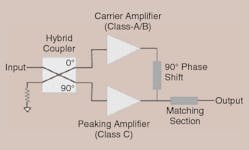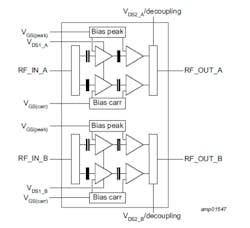Multistage Doherty MMIC Driver Eliminates Need for Interstage Isolation
The Doherty amplifier idea isn’t new: this modified class-B radio-frequency power amplifier (RF PA) configuration was devised by William H. Doherty of Bell Telephone Laboratories Inc in 1936, back in those early days of higher-power vacuum-tube amplifiers (Figure 1 and References 1 through 3).
Since then, it has been used extensively in specialized high-power applications where its efficiency benefits outweigh its significant additional complexity. Fortunately, advances in solid-state MMIC technology have nonetheless made it an increasingly viable architecture for power amplifiers in base stations and even portable applications.
Clear evidence of this “shrink” is provided by the B11G3338N80D from Ampleon Netherlands B.V., a fully integrated dual-section, three-stage Doherty MMIC solution using LDMOS process technology (Fig. 2). The carrier and peaking device, input splitter, output combiner, and pre-match are integrated in each section.
This 28-V multiband device, housed in a 36-lead, 12- × 7-mm PQFN package, is well-suited as a general-purpose driver for 3.3 to 3.8 GHz targeting high-power and macro base-station designs, including emerging 5G NR and legacy 4G LTE bands.
Due to its integrated design and push-pull configuration, the device eliminates the need for an interstage isolator, a major simplification. The built-in pre- and post-match circuitry offer 50-Ω input impedance and 25-Ω output impedance. It also features independent control of carrier and peaking biases, integrated ESD protection, and an integrated bias gate switch.
Output power at 3600 MHz is typically 48.7 dBm (1-dB gain compression), while power gain is 33 dB at 37 dBm output. The Doherty transistors typically deliver a drain efficiency of 22% at 12-dB power back-off and power gain of 34 dB at the vendor-cited test conditions.
Ampleon’s 14-page B11G3338N80D datasheet includes specifications, performance graphs, impedance information, and more. It also features a schematic, layout, and bill of materials (BOM) for a demonstration board (Fig. 3).
References
1. Doherty, W.H., Proceedings of the IRE,"A New High Efficiency Power Amplifier for Modulated Waves,” September 1936 (behind paywall but also posted here).
2. Doherty, W.H., US Patent US2210028A, “Amplifier,” August 1940.
3. Pengelly et al, IEEE Microwave Magazine, “Doherty's Legacy: A History of the Doherty Power Amplifier from 1936 to the Present Day,” February 2016 (behind paywall but also posted here).



